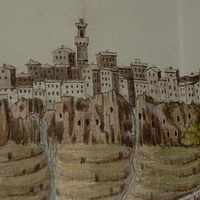Festschrift by William Chester Jordan
Cover illustration: The Pierpont Morgan Library, New York. MS M.638, fol. 8v. Purchased by J.P. M... more Cover illustration: The Pierpont Morgan Library, New York. MS M.638, fol. 8v. Purchased by J.P. Morgan (1867-1943) in 1916. With kind permission of the Morgan Library and Museum.
Articles & Reviews by William Chester Jordan

For a full list of manuscripts, editions, and translations, see "La chronique d'un Ménestrel de R... more For a full list of manuscripts, editions, and translations, see "La chronique d'un Ménestrel de Reims," ARLIMA: archives de littérature du moyen âge, online at https://www.arlima .net/mp/menestrel_de_reims_chronique_dun.html. xvii xviii Introduction text Natalis de Wailly chose for his edition, may be defective. In the words of one commentator, it has "neither a proper beginning nor ending."4 This deficiency makes it difficult to determine whether a different "original" composition preceded the version of the text that we have. If one did precede it, scholars may be engaging a set of récits worked and reworked, in the process now known as remaniement, by one or more hands. Author and Minstrel might therefore be plural figures.5 So, although I shall follow convention and use masculine pronouns when referring to the supposed author(s), I remain sensitive to the problem of unreflectively regarding anonymous texts, especially those classified as songs but others as well, as maleauthored.6 I drew on the Minstrel's récits for my first book when discussing the relationship between Queen Dowager Blanche of Castile and her son, Louis IX (Saint Louis).7 For readers who would not have been able to comprehend the Old French, however, I turned to the only English translation readily availableat least, available in major university libraries-that published by Edward Noble Stone in 1939.8 When not archaic, its prose was stolid at best. Recognizing its weaknesses, Robert Levine prepared a new translation of what his publisher advertised as 4. Lindy Grant, "Récit d'un ménestrel de Reims," in Encyclopedia of the Medieval Chronicle (Brill), online at http://referenceworks.brillonline.com/entries/encyclo pedia-of-the-medieval-chronicle/recit-dun-menestrel-de-reims-SIM_02160. 5. I capitalize "Minstrel" when I refer to the author and employ lowercase for the general category. 6.

Born in 1207, Henry III came to the throne in 1216 and reigned-though did not always rule-until h... more Born in 1207, Henry III came to the throne in 1216 and reigned-though did not always rule-until his death in 1272. The caveat derives from the fact that in 1258, when the narrative of Henry III, 1207-1258: The Rise to Power and Personal Rule ends, an alliance of magnates was preparing to seize power and rule in the king's name. Several scholars call the imposition and experience of baronial rule from 1258 to 1265 the first English Revolution, and it is a favorite phrase of the author of this book, David Carpenter. The fundamental question Carpenter confronts is, "How did Henry III get himself into such straits?" The volume-the first of two planned volumes on Henry's rule-consists of a linked set of studies that address this issue, including the organization of his court, his relations with his wife, the nature of his interactions with his extended family, his personal artistic taste, his piety, and his management of (or failure to manage) his expenses. Henry III was not a warrior king. He did not even like tournaments or hunting. Falconry was fun. He gave his birds pet names. He called a white gyrfalcon "Blackman" and others "Refuse, Blanchepenny, Pilgrim, Lespaynol" (24, 411). Carpenter implies that the monarch's fondness for and time spent with his birds relate to his distaste for work, and he meticulously documents Henry's laziness in general. When war came, the king was reluctant to lead troops into battle. He had a mercurial character-laying sieges and lifting sieges in rapid succession, failures to follow up on advantages his commanders achieved, hot anger momentarily uncontrollable, which he could not harness to good effect, and the like. This was true of his military encounters in Britain per se and of the two times he mounted disastrous invasions of France to redeem the Plantagenet holdings his father had lost. It was, of course, not a reign of uninterrupted tragedy. Henry could plan, and when motivated strongly he could scrape together large amounts of treasure, as, for example, by mulcting English Jews, for campaigns both military and non-military, but he was far more effective in carrying through projects on the non-military side. He loved to build and poured vast sums into his pride and joy, Westminster Abbey and the shrine of his patron, Edward the Confessor. He gave alms to the poor in staggering amounts. He tried to adhere to the oft-reconfirmed Charter, the legacy of his father's reign. Sometimes he slipped up, but he was not a tyrant. His largesse to his friends and relatives, especially his so-called foreign kin (half-siblings from western France, where his mother remarried, and relatives through his wife from Provence and Savoy), was over the top. Some native English magnates benefited, but the political nation at large hated the aliens, as they called them, especially the ones from western France. Henry was also, to put it politely, a little slow. Carpenter speculates that Henry's own twelveyear-old bride pleased him at age twenty-eight, when he married her, precisely because she was someone whom he could actually govern or who was, as Carpenter more delicately puts it, "very much his to mould" (180). She, however, matured steadily. "Eleanor was a wise woman" and, being "far stronger and more intelligent than her husband," achieved her own personhood (562). Governing the realm was harder. Henry recalled, improved, and reissued the currency, a genuine success, but some of the king's monetary policies, like his attempt at bimetallism, were incomprehensible, indeed inane. He liked to play as an adult, but he endangered people who joined him (Carpenter documents a drowning). He wanted unalloyed praise, so when he detected sarcasm he reacted fiercely, condemning his jester to death, in one instance, for a harmless if a biting quip. Wiser heads prevailed, and Henry rescinded the order. Yet he did not absorb the deeper lesson of kingly self-restraint. Carpenter is able to recover and relate all these anecdotes because the records are so good and because he is a true master of it, but he bends over backwards, too far I think, to excuse Book Reviews ▪ 187

Stimulated by suggestions-and corrections-that Jacques Dalarun made while he was translating my b... more Stimulated by suggestions-and corrections-that Jacques Dalarun made while he was translating my book on the resettlement in northern France of approximately 1500 former Muslims in the mid-thirteenth century, I undertook to write a new preface indicating points where further research might lead to the expansion and enrichment of my arguments 1. The present essay is a contribution in the same spirit, and it speaks to the informal collaboration-the dialog between Professor Dalarun and myself during the translation process-from which history writing, which is always a work in progress, benefits in a substantive way. It is also a thank-offering, although an inadequate one, for Professor Dalarun's personal kindness and scholarly generosity. Let me begin where the book begins, its title, drawn from the bible, The Apple of His Eye. It is the phrase that Guillaume de Chartres, one of Louis IX's closest confidants and the author of a brief memoir about him, used to describe the king's love and care for his subjects. My former student, Randall Todd Pippenger, reminded me that Jean de Joinville in his Life of Saint Louis, a text I have read and taught countless times, quoted the phrase in a very different context. Jean wrote that a Mauritanian, which is to say, one of the many Berbers who had long played an important military, though sometimes disruptive, role in Egyptian history 2 , Sebreci by name, had a key part in the dramatic events of the French king's captivity on crusade in 1250. Most significant, Sebreci expressed misgivings about the inclination of his companions to kill the king and the French sub-commanders whom they held prisoner after the Battle of Mansourah 3 .

The aim of this study is to attain a proper identification of Philippus de Caturco, an exemplary ... more The aim of this study is to attain a proper identification of Philippus de Caturco, an exemplary administrator in France in the thirteenth century. Philippe, to use the vernacular form of his Christian name, was a judicial official in the archidiaconal court of Reims early in his career in the mid-1250s, and subsequently a junior clerk in the Parlement of Paris, an enquêteur delegated to carry out special investigations for the crown, a Master of the King's Court (the highest judicial office in Parlement), the Keeper of the Royal Seal (effectively, Chancellor), provisional (back-up) co-regent of the kingdom in 1270, and the bishop of Évreux from that date until his death in 1281. 1 Although many scholars have understood the appellation de Caturco as signifying his place of origin or childhood as the town of Cahors, others have preferred the village of Chaource. The brilliant late nineteenth-and early twentieth-century scholar, Léopold Delisle, favoured the former. In volume 23 of the Recueil des historiens des gaules et de la France, which Delisle helped edit, he dismissed the idea that de Caturco should be translated de Chaource. 2 In his 'Chronologie des baillis et des sénéchaux royaux' in volume 24 of the same collection, he reiterated his view and made it clear once again that he could not fathom why several other prominent historians, in particular the intellectually dyspeptic Colonel Léon-Louis Borrelli de Serres, whose views I discuss below, would opt for the latter. 3 Louis Carolus-Barré, the great expert on the acta of Louis IX, the king (1226-1270) for whom the administrator worked for almost fifteen years, preferred Philippe de Cahors as well. 4 Even Carolus-Barré's great authority has not persuaded several adherents of Borrelli's opinion. Until recently, and under the spell of the declamatory influence of the learned colonel, I too referred to Philippe For a comprehensive treatment of his life and work, see Jordan, Servant of the Crown and Steward of the Church. Recueil des historiens des Gaules et de la France, ed. by Bouquet and others, xxiii, 482 n. 5. Delisle, 'Chronologie des baillis et des sénéchaux royaux' , p. 26* n. 17. Those sharing Delisle's view have included Boutaric, '

The pre sent book, Knights, Lords, and Ladies: In Search of Aristocrats in the Paris Region, 1180... more The pre sent book, Knights, Lords, and Ladies: In Search of Aristocrats in the Paris Region, 1180-1220, was Professor John Baldwin's last. The distinguished Johns Hopkins University historian completed a full draft of the manuscript, which he had submitted to the University of Pennsylvania Press before his death. The readers whom the Press solicited were enthusiastic about the manuscript. Although they had suggestions for final revisions, as readers always have, they were in agreement that the manuscript was excellently argued, impor tant substantively, clearly written, and, for all these reasons, worthy of publication. Unfortunately, Baldwin passed away before he could engage with their suggestions. Every one concerned in the production of this volume, however, believes that even without his response to the readers' reports and what might have been his own potential recommendations for additional revisions, the manuscript was a power ful and learned exemplar of scholarship and representative of the interests and thrust of the entire corpus of Baldwin's impressive work. Careful copyediting and the verification of references and statistics rather than stylistic or orga nizational changes have thus guided the transition from the manuscript to the book. In its current state, the study must be very close to the volume that John Baldwin intended it to be. Knights, Lords, and Ladies, as I have already implied, appears at the end of a series of Baldwin's scholarly interventions in the course of a very long and productive career. Indeed, even without its publication, scholars would consider his contribution to medieval studies profound. Only forty-one when his twovolume Masters, Princes, and Merchants: The Social Views of Peter the Chanter and His Circle appeared in 1970, Baldwin provided scholars in the first volume of that work precise and supremely intelligent reconstructions of some of the leading moral issues discussed by scholars in Catholic Eu rope in the late twelfth and early thirteenth centuries. In doing so, he demonstrated his impressive paleographic skills and his wide-ranging command of scholastic philosophy, theology, and canon law. The second volume made numerous excerpts of the texts
William C. Jordan, “Learning about Jews in the Classroom: A Thirteenth-Century Witness, UCLA Library, Rouse MS 17,” in Ra’anan S. Boustan, et al., eds., Envisioning Judaism: Studies in Honor of Peter Schäfer on the Occasion of his Seventieth Birthday, vol. 2 (Tübingen: Mohr Siebeck, 2013), 1247-1260
The chilling biblical story of Herodias' young daughter (known elsewhere by name of Salome) and h... more The chilling biblical story of Herodias' young daughter (known elsewhere by name of Salome) and her role in the execution of John the Baptist has fascinated interpre down the ages. This article explores medieval exegetical traditions with regard to the girl the remarkable way her story was construed as pointing both to the horrific consequence lust and anger and to the meta-narrative of the rise of the church, figured in Salome, the ho of salvation.








Uploads
Festschrift by William Chester Jordan
Articles & Reviews by William Chester Jordan